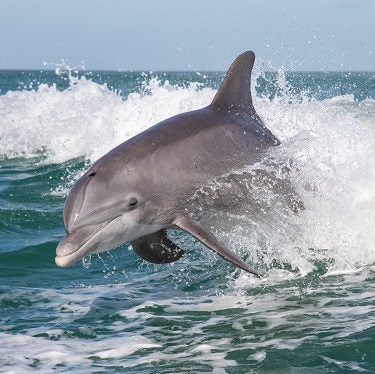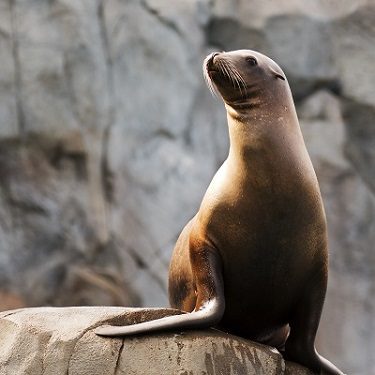Marine Life Encyclopedia
Marine Mammals
Beluga Whale
Delphinapterus Leucas
Distribution
Restricted to subpolar and polar waters above the Arctic Circle
eCOSYSTEM/HABITAT
Shallow, coastal waters and near the ice edge; sometimes in rivers
FEEDING HABITS
Foraging predator
TAXONOMY
Suborder Odontoceti (toothed whales), Family Monodontidae (white whales)
Belugas, however, are typically more solidly white than their grayish cousins. Adult belugas are also slightly larger than narwhals, reaching lengths of around 18 feet (5.5 m). Interestingly, the beluga whale is the only species of cetacean (whales and dolphins) that has a movable neck. Belugas can move their heads up and down and from side to side.
Beluga whales are restricted to the Arctic Ocean and adjacent waters. They feed in shallow, coastal waters during the summer and near the ice edge [link] in winter. Some populations undergo long, seasonal migrations, while others are more resident in nature. They eat a variety of fish and invertebrate prey. Killer whales and polar bears have been known to attack and eat beluga whales. Scientists believe that belugas may swim far into ice-covered waters to avoid orcas but that this may put them in greater risk of predation by polar bears. When hunting belugas, polar bears use their incredible strength to pull them onto the ice surface whenever they come to a hole to breathe.
Occasionally, belugas can be observed far inland, swimming up coastal rivers as far as hundreds of miles. Scientists do not know if these trips into freshwater are for feeding or for other purposes, but belugas are apparently unafraid of very shallow water. In fact, some individuals have been known to survive being stranded/beached by patiently waiting for the return of the high tide. Belugas are also known for their loud, clear vocalizations. They often “sing,” and can even be heard above the ocean surface by people in boats or onshore.
Conservation scientists consider the beluga to be near threatened with extinction. Climate change is causing rapid changes to the Arctic ecosystem that affect beluga habitat, and chemical pollution in the Arctic is particularly bad, risking the health of large predators like this species. These whales are hunted, legally, by indigenous peoples all around the Arctic, but this ongoing hunt is not generally thought to threaten the species. Climate change and pollution are likely more significant threats to beluga populations, though further research is necessary before accurate predictions can be made.
Fun Facts About Beluga Whales
1. Beluga whales grow up to 16 feet (4.8 m) long and weigh 3,150 pounds (1.4 metric tons) on average.
2. Beluga whales can live up to 50 years.
3. Beluga whales are born dark gray and get lighter as they age, eventually becoming white once they’ve reached sexual maturity.
4. Beluga whales can dive more than 3,280 feet (1,000 m) and stay under for up to 25 minutes at a time.
5. Beluga whales live in Arctic waters and sometimes venture into freshwater rivers.
6. Beluga whales shed their skin each summer by rubbing against coarse gravel.1
7. Beluga whales do not have fused neck vertebrae like other whales, which allows them to move their heads up, down and side to side.
8. Beluga whales have bulbous, flexible foreheads called “melons” that help them produce sound and make facial expressions.
9. Beluga whales are often called the “canaries of the sea” because they vocalize many different sounds, including clicks, whistles, chirps and squeals.2
Engage Youth with Sailors for the Sea
Oceana joined forces with Sailors for the Sea, an ocean conservation organization dedicated to educating and engaging the world’s boating community. Sailors for the Sea developed the KELP (Kids Environmental Lesson Plans) program to create the next generation of ocean stewards. Click here or below to download hands-on marine science activities for kids.
References:
2 Alaska Fisheries Science Center
Get Involved

Donate Today
SUPPORT OUR WORK TO PROTECT THE OCEANS BY GIVING TODAY
With the support of more than 1 million activists like you, we have already protected nearly 4 million square miles of ocean.

TAKE ACTION NOW
Support policy change for the oceans
Decision-makers need to hear from ocean lovers like you. Make your voice heard!

VISIT OUR ADOPTION CENTER
SYMBOLICALLY ADOPT AN ANIMAL TODAY
Visit our online store to see all the ocean animals you can symbolically adopt, either for yourself or as a gift for someone else.

DOWNLOAD OCEAN ACTIVITIES
HELP KIDS DISCOVER OUR BLUE PLANET
Our free KELP (Kids Environmental Lesson Plans) empower children to learn about and protect our oceans!




